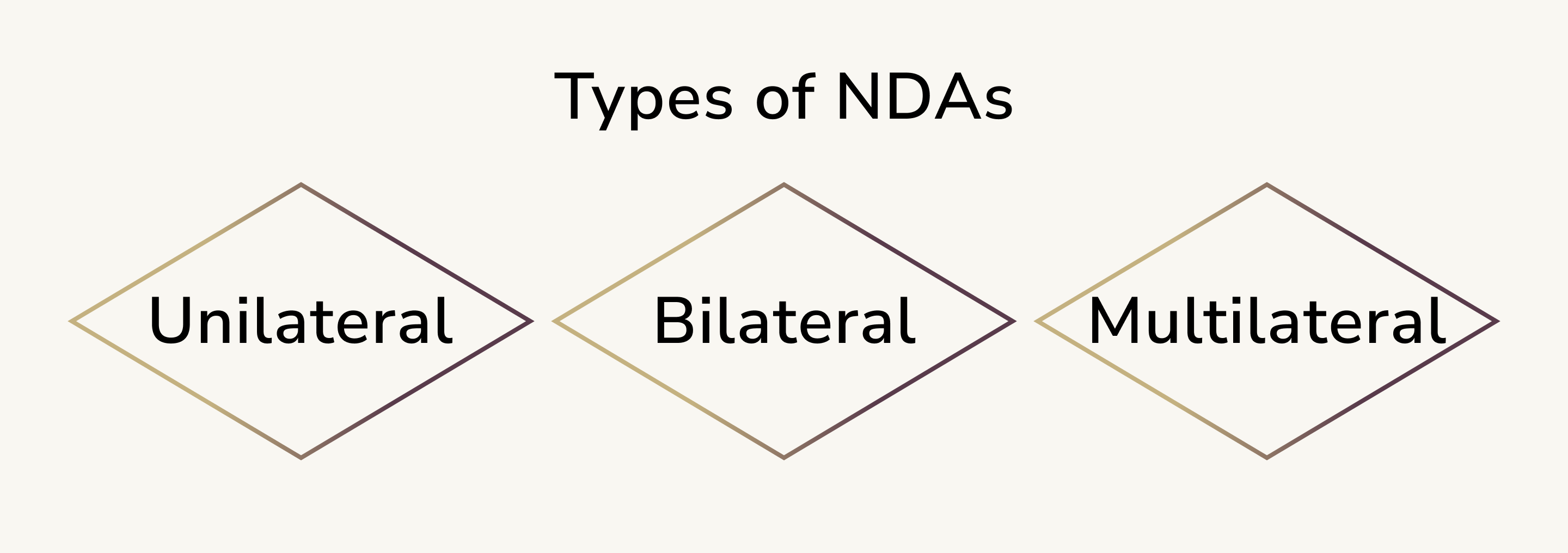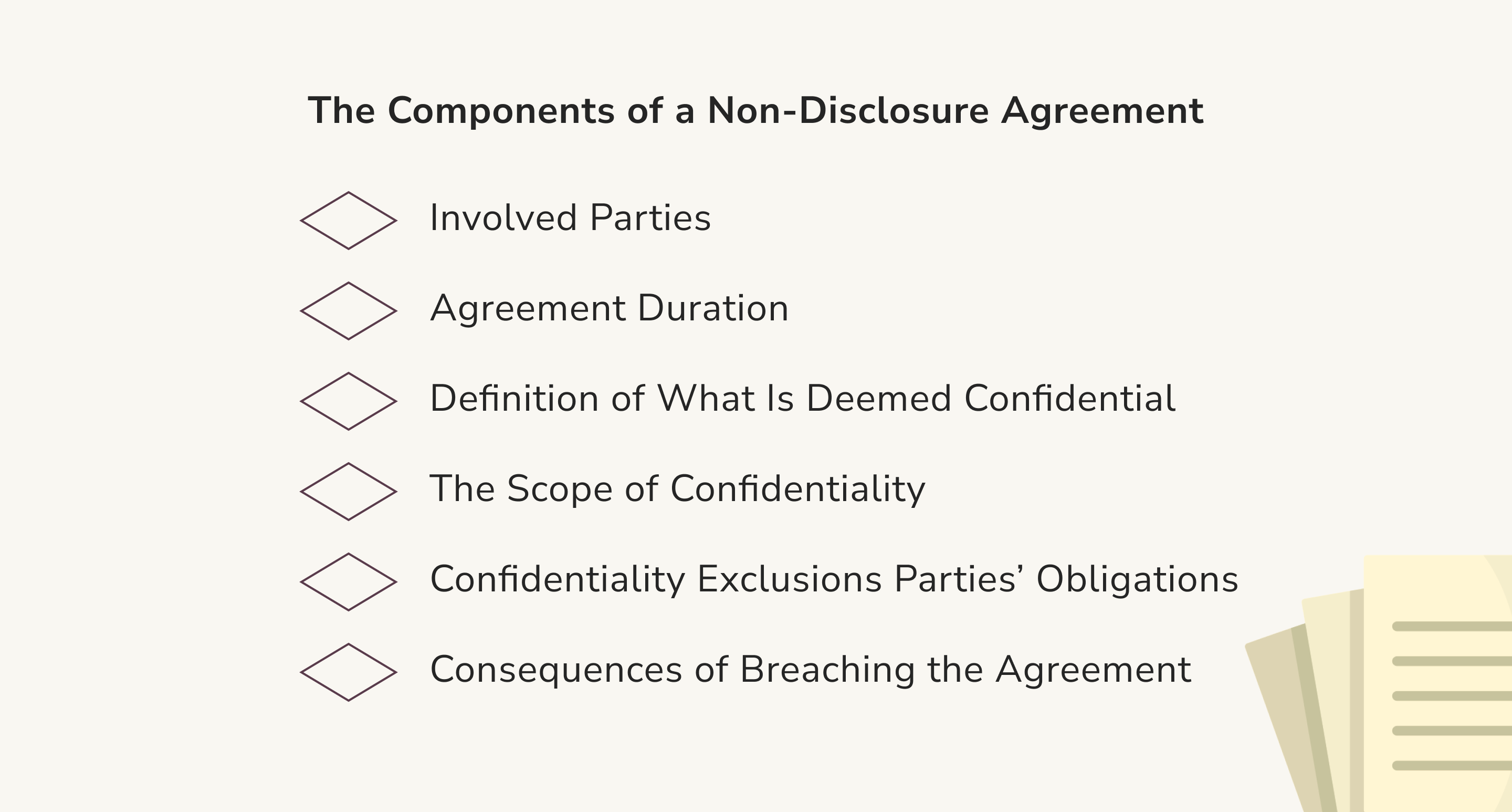NDA for Software Development: Guide and Example

When starting your own project or beginning to develop your own product, it's easy to get bogged down in numerous tasks and miss important points.
No one would argue that protecting confidential information is important. On the other hand, drafting a non-disclosure agreement is often not done with the required level of care and attention to detail. People use ready-made drafts without making any edits, and as a result, they get weak or ineffective documents.
Whether you plan to hire a software company to develop a web application or for cross platform mobile app development service, you need to sign this document. Therefore, this article intended for novice business people will cover all the important aspects and details that should be taken into account when drafting and signing an NDA.
What is an NDA?
Let's begin with a simple definition. A non-disclosure agreement is a legal document concluded between two or more parties, the main function of which is to protect confidential information. In this way, companies protect private data to avoid leakage, theft, or disclosure of industrial or corporate secrets.
Non-disclosure agreements may be concluded between all the different parties (employers and employees, sellers and buyers, customers and vendors, clients and contractors, business partners, etc.). You can also come across terms like confidentiality agreements (CAs), confidential disclosure agreements (CDAs), and proprietary information agreements (PIAs), which basically mean the same thing as an NDA.
In the case of software development, a non-disclosure agreement is usually concluded between the customer (the owner of a company or a startup) and an IT outsourcing company that was hired to develop custom software according to the customer's requirements.
Why and When Do You Need an NDA?
Now knowing what is an NDA, let's see what are the most common situations that may require using a non-disclosure agreement. So according to Forbes, these are the usual cases for an NDA:
- If you show a business idea or an invention to a potential business partner, investor, or distributor;
- If you receive services from a company that would have access to your sensitive information;
- If you share marketing, financial, and other information with a prospective buyer of your business;
- If your employees have access to confidential and proprietary information about your business;
While the situations that you actually do not need to sign NDA for include:
- If you are a startup owner presenting your idea to venture capitalists (they usually simply refuse to sign such agreements);
- If you are a startup founder with merely a business idea;
- If you are using public information;
- If you are at the initial stage of looking for a contractor\vendor;
Types of NDAs
Let’s dive a bit deeper into the features of non-disclosure agreements. What you need to know is that there are different types of NDA depending on the number of parties involved, who signs the document as well as on the duration of the agreement.

Unilateral
This is the type of non-disclosure agreement that is probably the most common when we talk about NDAs in the field of software development. In this case, only one party shares confidential information that must be protected, and the agreement is signed to ensure that the second party won’t leak any of it.
Depending on who will sign the agreement, the following types of contracts are distinguished:
- Employer-employee NDA
- Company-contractor NDA
- Inventor-evaluator NDA
- Seller-buyer NDA
Bilateral
As the title suggests, in this case, both parties share some sensitive information that should not be shared publicly. Such an agreement limits who, when, where, and how can share and use confidential information.
However, sometimes one party may suggest signing a bilateral NDA even though only one party shares the confidential information. It is done to ensure that certain information remains confidential in any case.
You can also see the terms “two-way NDA” or “mutual NDA” — they have the same meaning as the bilateral non-disclosure agreement.
Multilateral
In the event that three or more parties are involved in a joint business, it is unnecessary to develop separate unilateral and bilateral NDAs. For such situations, there are multilateral non-disclosure agreements.
Although it is a little more complicated to compose such an NDA, as it sometimes requires a deeper and longer negotiation process that would include all the parties, this document will protect the interests and private information both in the case that it is shared by only one party, and in the event that such info shared by all parties involved.
Definite vs Indefinite
One of the things that are to be carefully considered during the NDA drafting is the duration of the agreement. While a definite type is one that lasts for a fixed period of time, an indefinite one runs forever. It means that after signing an indefinite-duration NDA one can’t disclose any information even if the years have passed after the end of the cooperation of the parties involved.
What Should be Included in an NDA?
A good non-disclosure agreement should not be long to be of high quality and to perform its function effectively. However, even though each NDA should be tailored to your needs and specifics, there is a list of certain components that any NDA must include.
Involved Parties
First and foremost, you have to identify the parties involved. Two main parties are:
- Owner of the information (usually named “Disclosing Party” or “Discloser” in the agreement”);
- Recipient (“Receiving Party” or “Recipient”).
However, in case the receiving party will have to share parts of the confidential information with their own partners, vendors, or contractors in order to accomplish the job, these third parties and their involvement should also be specified in the document.
For instance, let’s pretend you are a startup owner and looking to work with a software development partner. In this case, you will act as a Disclosing Party, and the software development company you chose will act as a Receiving Party. And not only the software developers should sign the NDA but also everyone who has to do something with the development process — project manager, designer, QA engineers, etc.
Definition of What Is Deemed Confidential
Both parties are interested in this part being defined in as much detail as possible. What information will be considered confidential? Is it written information only or verbally transmitted as well? What specific information about a project or product is private and what has already been made public?
For the Disclosing Party, it is obviously necessary in order to close all the possible loopholes and actually protect what should be protected.
In its turn, for the Receiving Party, it is important because it gives them a clear understanding of what information they are allowed to disclose without getting sued (for example, if we’re talking about an IT company, what can be said in a case study or included in the portfolio).
Agreement Duration
As we’ve already mentioned before, an NDA may last for an indefinite period of time and have a duration of a couple of years. Although it may seem that a non-disclosure agreement that lasts for an indefinite period of time is a great idea, in reality, most of the sensitive information becomes useless after a few years.
Therefore, most NDAs have a duration of 2-5 years. But as Richard Harroch recommends in a Forbes article “NDA also needs to say that, even if the term is ended, the disclosing party isn’t giving up any other rights that it may have under copyright, patent, or other intellectual property laws.”
The Scope of Confidentiality
After determining what information will be considered confidential in the business relationship of the parties, it is also necessary to determine the scope of confidentiality. This clause usually includes 2 conditions:
- The Receiving party does not disclose secret information;
- The Receiving party not using confidential information.
In the first case, it is implied that the Recipient must take appropriate measures to ensure that confidential information does not leak out and fall into the wrong hands. In order to do this, for example, the agreement may stipulate who from the Recipient's company will have access to secret information.
In the second case, the NDA should clearly state how and which sensitive information can be used, and which information is provided just for familiarization.

Confidentiality Exclusions Parties’ Obligations
One should also remember to include clear exclusion clauses in the non-disclosure agreement. Therefore, such exceptions may include the following:
- publicly known information;
- information that the Recipient received from third parties that were not included in the NDA;
- information produced by the Recipient without the use of sensitive data obtained from the Discloser;
The Recipient is particularly interested in this clause as it may save them from lawsuits in case of ambiguous situations.
Consequences of Breaching the Agreement
This is perhaps one of the most important points of the agreement. It should address the consequences of a potential leak of private information. Usually, an NDA includes a clause on financial compensation in case of disclosure of confidential information — specifically the amount and terms of payment.
However, this clause may also contain a detailed description of possible methods of resolving the legal conflict. For example, options on alternative dispute resolutions (such as negotiation, mediation, or arbitration) may be included there.
NDA Example
Now that you have read all the theoretical information on how to properly draft an NDA without missing any important points and taking into account all the details, it is also time to review what a sample non-disclosure agreement might look like.
For your convenience, below we have laid out an example of the simplest unilateral (one-way) NDA. Please note that this NDA template document is for informational purposes only. Of course, you can try to draft your own non-disclosure agreement; however, we still recommend that you always consult with legal professionals regarding important documents.
This Nondisclosure Agreement or ("Agreement") has been entered into on the date of DD\MM\YYYY (or MM\DD\YYYY for the US) and is by and between: [NAME OF COMPANY RECEIVING INFORMATION] a company registered in [COUNTRY] whose registered office is at [address of office] (“Receiving Party”) and [NAME OF COMPANY DISCLOSING INFORMATION], a company registered in [COUNTRY] whose registered office is at [address of office](“Disclosing Party”) for the purpose of preventing the unauthorized disclosure of Confidential Information as defined below. The parties agree to enter into a confidential relationship concerning the disclosure of certain proprietary and confidential information ("Confidential Information").
This Agreement and each party's obligations shall be binding on the representatives, assigns, and successors of such party. Each party has signed this Agreement through its authorized representative. DISCLOSING PARTY Signature: Typed or Printed Name: Date: RECEIVING PARTY Signature: Typed or Printed Name: Date: |
You can get more non-disclosure agreement templates and samples of different types of NDAs here.
Conclusion
Drawing up agreements and documents cannot be called the most interesting activity. These procedures often seem complicated and tedious. However, it cannot be disputed that they are extremely important and their absence can cost you and your business a lot of time and money.
Properly written NDA will protect your intellectual property including all unique ideas and innovative approaches so they will not become known to competitors. In addition to the non-disclosure agreement, there are some other documents that you should know about — read our article to be informed. Also, you might be interested in other articles about documentation, for example, our piece on the statement of work.
If you have an interesting business idea and are looking to hire dedicated development team to implement it — message us and we will gladly get in touch.

Roman Zomko
Other articles